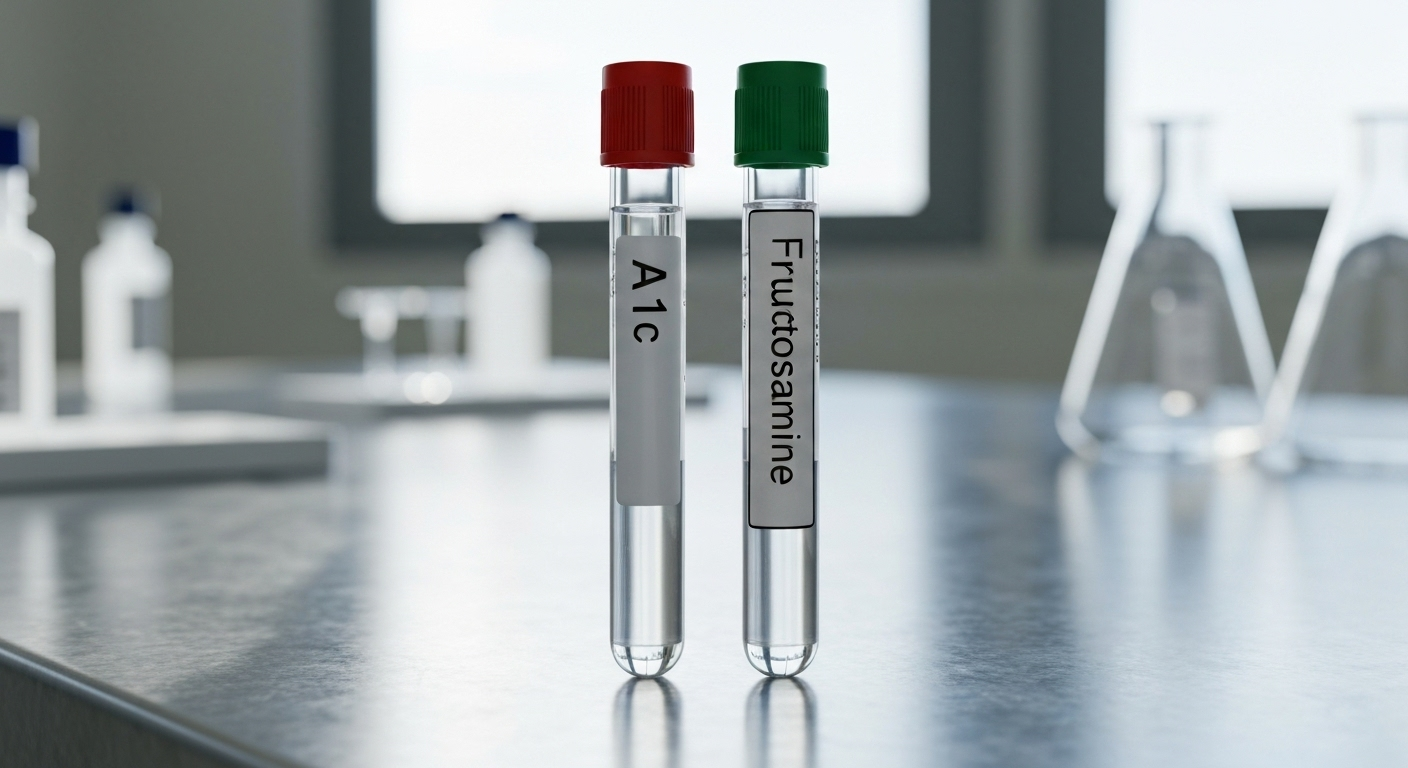
Key Highlights
Here are the key takeaways when comparing the A1c and fructosamine tests:
- The A1c test measures your average blood glucose over two to three months.
- The fructosamine test provides a shorter-term view, reflecting your average glucose levels over the past one to three weeks.
- Fructosamine is a useful alternative when A1c results might be inaccurate due to conditions like anemia or kidney disease.
- This test is also helpful for monitoring recent changes in your diabetes management plan, such as new medications or insulin adjustments.
- Your healthcare provider can use these test results to fine-tune your approach to glycemic control.
Introduction
Managing diabetes mellitus effectively hinges on understanding your blood glucose trends. While many are familiar with the standard A1c test, another valuable tool exists: the fructosamine test. This test offers a different perspective on your recent glucose control, providing crucial information in a shorter time frame. Understanding the differences between these two tests can empower you and your healthcare provider to make more informed decisions about your diabetes management plan. Are you curious about which test is right for you?
Overview of A1c and Fructosamine Tests
When monitoring diabetes mellitus, the goal is to get a clear picture of your blood glucose levels. Both the A1c and fructosamine tests help achieve this, but they look at different time windows. Your healthcare provider uses these tools to see how well your current glucose control plan is working and if adjustments are needed.
Each test measures how glucose attaches to different proteins in your blood, and the results are compared to a reference range. Let’s look closer at what each test specifically measures.
Understanding Hemoglobin A1c
The hemoglobin A1c test, also known as the HbA1c or glycated hemoglobin test, is a common method for assessing long-term glycemic control. It measures the percentage of your hemoglobin—a protein in red blood cells—that has glucose attached to it. This process of glucose binding to hemoglobin is called glycation.
Because red blood cells have a lifespan of about three months, the A1c test provides a snapshot of your average blood glucose over that period. It has become a standard tool in diabetes management for tracking how well your treatment plan has been working over the long term.
However, certain conditions can affect the accuracy of an A1c test. Hemoglobin variants or conditions that alter the lifespan of red blood cells can lead to misleading results, making it important to consider alternative tests in some situations.
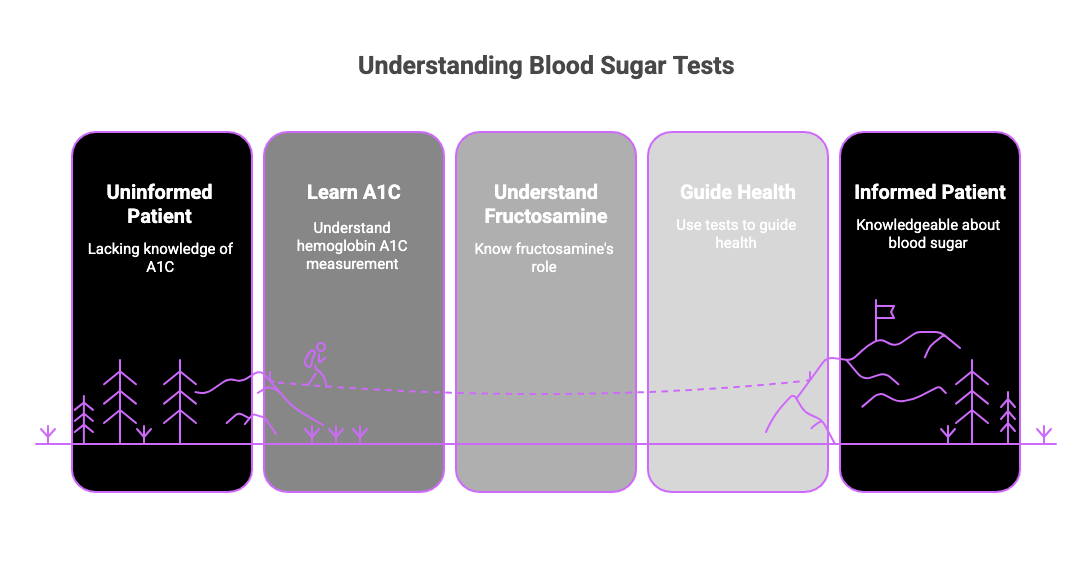
What Is Fructosamine?
So, what is fructosamine? This test measures glycated albumin and other serum proteins in your blood. Similar to how glucose attaches to hemoglobin, it also binds to these proteins. The key difference is that these proteins, particularly albumin, have a much shorter lifespan in the body, typically around two to three weeks.
This shorter cycle means the fructosamine level reflects your average blood sugar over a more recent period—just the last one to three weeks. A higher fructosamine concentration indicates that your average blood glucose has been elevated during that time.
Because it doesn’t rely on hemoglobin, the fructosamine test serves as one of the important alternative markers for monitoring blood sugar. It’s particularly useful when an A1c test might not be reliable, providing a valuable tool for short-term diabetes management.
How Each Test Measures Blood Sugar Control
The fundamental difference between A1c and fructosamine lies in what they measure and over what period. Think of the A1c as a long-term report card and the fructosamine test as a recent quiz on your blood glucose control. Both provide an average glucose reading, but their time frames give your healthcare provider distinct insights.
These differences are crucial for interpreting your test results correctly and making timely adjustments to your care plan, especially when compared with daily readings from continuous glucose monitoring. Now, we’ll examine the specific time frames and biological markers for each test.
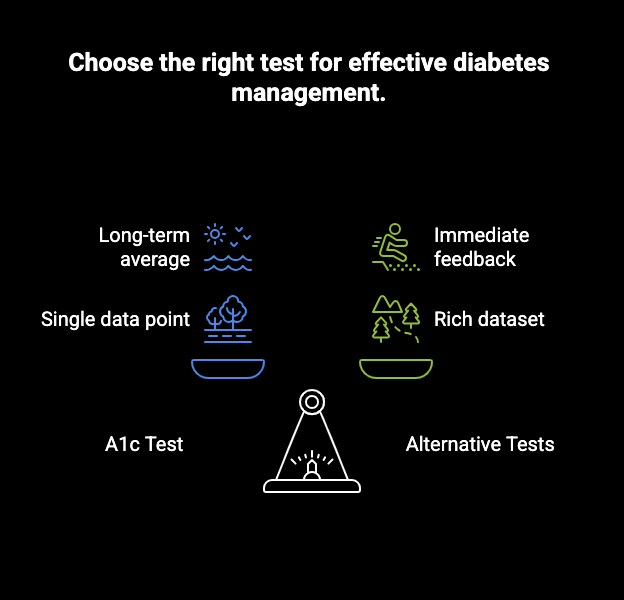
Time Frames Assessed by A1c vs Fructosamine
As mentioned, the A1c test assesses your average blood glucose levels over a long period, typically two to three months. This extended view is valuable for understanding your overall, long-term glycemic control and the effectiveness of your established diabetes care plan. It smooths out the daily ups and downs you might see with a continuous glucose monitor.
In contrast, the fructosamine test provides a short-term picture. It measures your average glucose over the preceding one to three weeks. This makes it highly sensitive to recent changes in your blood sugar.
This shorter time frame is especially helpful when you’ve just started a new medication or changed your insulin dosage. A blood sample for a fructosamine test can quickly show if these adjustments are working, without having to wait months for the A1c to reflect the changes.
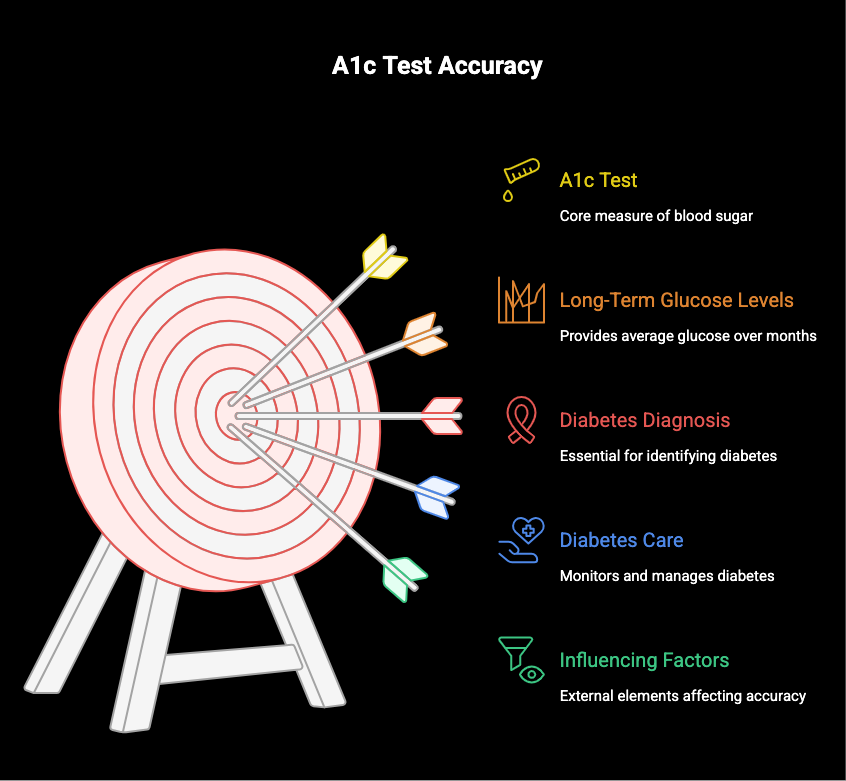
Situations Favoring Fructosamine Testing
So, when should you choose a fructosamine test instead of an A1c test? This test becomes particularly valuable when the A1c may be unreliable. Certain medical conditions can interfere with the normal life cycle of red blood cells, leading to falsely low A1c results.
For example, conditions like hemolytic anemia or sickle cell anemia cause red blood cells to break down more quickly. The same issue can arise after significant blood loss or a blood transfusion. In these cases, the fructosamine test, which doesn’t depend on red blood cells, provides a more accurate picture of recent blood sugar control.
Situations that often favor a fructosamine test include:
- Conditions affecting red blood cells, such as hemolytic anemia or sickle cell anemia.
- Chronic kidney disease, kidney failure, or nephrotic syndrome.
- Pregnancy, where rapid physiological changes can make A1c results less reliable.
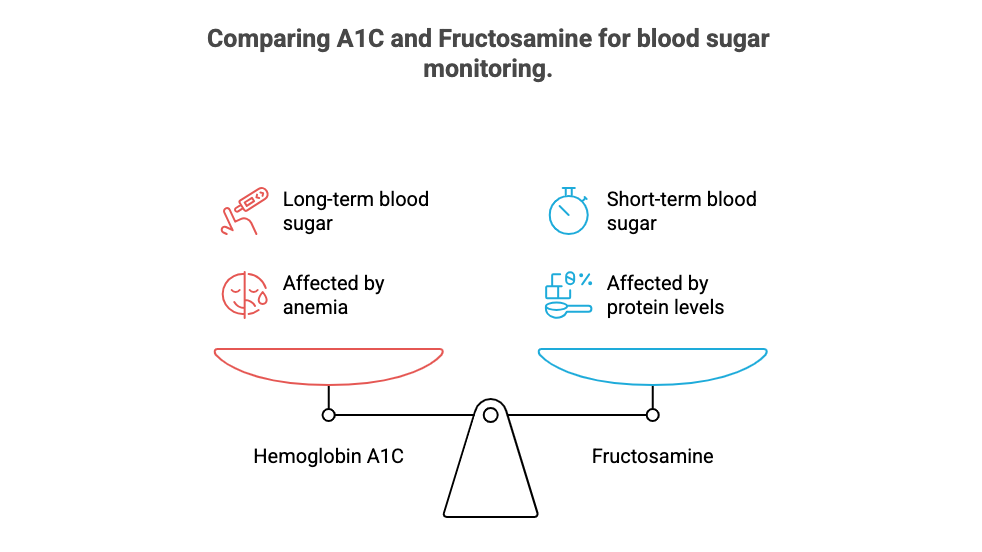
Factors Affecting Accuracy of A1c and Fructosamine
No test is perfect, and both A1c and fructosamine results can be influenced by certain factors. Medical conditions that affect the biological markers each test measures—hemoglobin for A1c and blood proteins for fructosamine—are the most common culprits. For instance, anemia or recent blood loss can skew A1c readings.
Understanding these potential interferences is key to interpreting your results correctly. Below, we’ll look at how specific health issues and other variables can impact the accuracy of these important diabetes tests.
Influence of Medical Conditions like Anemia and Kidney Disease
How do factors like anemia or kidney disease influence reliability? Medical conditions that alter the lifespan of red blood cells can significantly impact A1c accuracy. For example, hemolytic anemia causes red blood cells to be destroyed prematurely, resulting in a falsely low A1c because there isn’t enough time for glucose to accumulate on the hemoglobin.
Similarly, chronic kidney disease can affect both tests. It can cause anemia, which skews A1c results. It can also lead to low levels of albumin, the main protein measured by the fructosamine test, potentially affecting its accuracy as well. A condition like nephrotic syndrome, a kidney disorder, can also cause low fructosamine levels.
Here are some conditions that can affect test accuracy:
- Anemia: Falsely lowers A1c results.
- Kidney Disease: Can affect both A1c (due to anemia) and fructosamine (due to low protein levels).
- Liver Disease: Can impact protein levels, potentially affecting fructosamine results.
- Recent Blood Loss: Shortens red blood cell lifespan, lowering A1c.
Cost, Procedure, and Conversion Between Results
Do A1c and fructosamine tests cost differently or require different procedures? The procedure for both tests is a simple blood test, requiring a blood draw from a vein or a fingerstick. No special preparations like fasting are needed for either. However, as mentioned, you should avoid high-dose vitamin C supplements before a fructosamine test. Health insurance usually covers these tests if deemed medically necessary, but it’s always best to check with your provider.
Can the results of a fructosamine test be converted to an approximate A1c value? While there isn’t a universally accepted, direct formula to convert fructosamine test results to a precise A1c value, the results are correlated. High fructosamine levels indicate high average blood glucose, just as a high A1c does. Your doctor will interpret the trends in your fructosamine levels over time to manage your care.
|
Consideration |
A1c Test |
Fructosamine Test |
|---|---|---|
|
Procedure |
Simple blood draw or fingerstick. |
Simple blood draw or fingerstick. |
|
Preparation |
No special preparation needed. |
Avoid high-dose vitamin C for 24 hours prior. |
|
Cost |
Generally covered by health insurance for routine diabetes monitoring. |
May require justification of medical necessity for insurance coverage. |
|
Results |
Reflects average blood sugar over 2-3 months. |
Reflects average blood sugar over 1-3 weeks. |
Conclusion
In summary, understanding the differences between A1c and fructosamine tests is crucial for effectively managing blood sugar levels. Each test offers unique insights into glucose control over different time frames, making it essential to choose the right one based on your individual needs. Factors such as medical conditions and personal circumstances can influence the accuracy of these tests, so being informed will help you make more effective health decisions. Staying proactive in monitoring your blood sugar is vital for long-term health. If you have any questions or want personalized guidance, don’t hesitate to reach out for a free consultation today!
Frequently Asked Questions
Can fructosamine results be converted to an A1c value?
While a direct mathematical conversion is not standard practice, your fructosamine test results can be correlated with an A1c value. A higher fructosamine level generally corresponds to a higher A1c, as both indicate elevated blood sugar. Your doctor will interpret the results within their respective reference range to assess your glycemic control.
Is fructosamine better for people with rapidly changing blood sugar levels?
Yes, the fructosamine test is often better for monitoring rapidly changing blood sugar. Because it reflects your average blood glucose levels over a short term of one to three weeks, it can quickly show the effects of new medications or lifestyle adjustments, unlike the A1c, which takes months to change.
Which test is best for monitoring short-term blood sugar changes?
The fructosamine test is the superior choice for monitoring short-term blood sugar levels. Its ability to measure the average glucose levels over the past one to three weeks provides rapid feedback, making it an excellent tool in diabetes management for assessing recent changes in your treatment plan.


